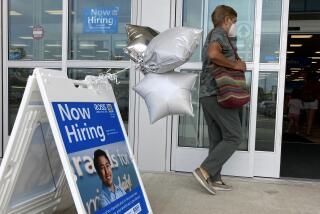White House Scales Back Economic Growth Forecast
- Share via
WASHINGTON — The Bush administration nudged its economic forecast slightly downward Friday in the first preview of the numbers that will be in the 2006 budget presented to Congress early next year.
Its new forecast was in line with the consensus of private economists.
For the record:
12:00 a.m. Dec. 22, 2004 For The Record
Los Angeles Times Wednesday December 22, 2004 Home Edition Main News Part A Page 2 National Desk 1 inches; 48 words Type of Material: Correction
Economic forecast -- An article in Saturday’s Section A said an economic forecast issued Friday by the White House predicted economic growth of 3.5% in 2005. This is the same growth rate that the White House foresaw in July, rather than a lower rate, as the article reported.
The administration’s new economic projection showed inflation-adjusted economic growth of 3.5% in 2005, the same growth rate as the average foreseen by 53 private economists who were surveyed Dec. 1 and 2 by Blue Chip Economic Indicators. In its most recent previous forecast, in July, the administration had predicted economic growth of 3.7% in 2005.
“The economy is in very solid shape,” Gregory Mankiw, chairman of the president’s Council of Economic Advisers, told reporters.
Bush has pledged to cut the federal budget deficit, a record $413 billion in fiscal 2004, in half in five years.
Joshua B. Bolten, director of the White House Office of Management and Budget said, “This forecast shows that the pro-growth policies we’ve enacted will help generate the economic growth necessary to meet that goal.”
The new forecast showed the economy adding jobs at a rate of 175,000 a month during 2005, compared with 185,000 a month this year.
The economy has still not restored the number of jobs that it supported in January 2001, when Bush took office. The Labor Department reported that there were 132,075,000 jobs in November, 313,000 fewer than the month Bush was inaugurated.
In the new administration forecast, it was predicted that inflation would hover slightly above 2%, not only next year but through 2010.
The consumer price index is on course to rise 3.4% this year, a poorer performance than the 2.8% the administration projected in July.
For next year, the administration predicted only 2% price inflation, less than the 2.4% prediction in July and the 2.5% Blue Chip forecast. Inflation is expected to rise 2.3% in 2006 and 2.4% a year for the rest of the decade.
The Federal Reserve is in the process of raising short-term rates incrementally, and the administration’s projections implied that it thought the Fed’s campaign would continue.
The interest rate on a three-month Treasury bill, which the administration said would average 1.4% this year, was predicted to rise to 2.7% next year and 3.5% in 2006. The Blue Chip consensus was even higher: 2.9% for next year.
As for 10-year Treasury notes, the administration projected an average 4.6% rate next year and 5.2% in 2006.
“Given the powerful contractionary forces at work since early 2000, the strength of our economy is remarkable,” Mankiw said. “The United States faced the bursting of the high-tech bubble of the 1990s, corporate scandals and slow growth among our trading partners, and today our economy is strong and growing.”
More to Read
Get the L.A. Times Politics newsletter
Deeply reported insights into legislation, politics and policy from Sacramento, Washington and beyond. In your inbox twice per week.
You may occasionally receive promotional content from the Los Angeles Times.










